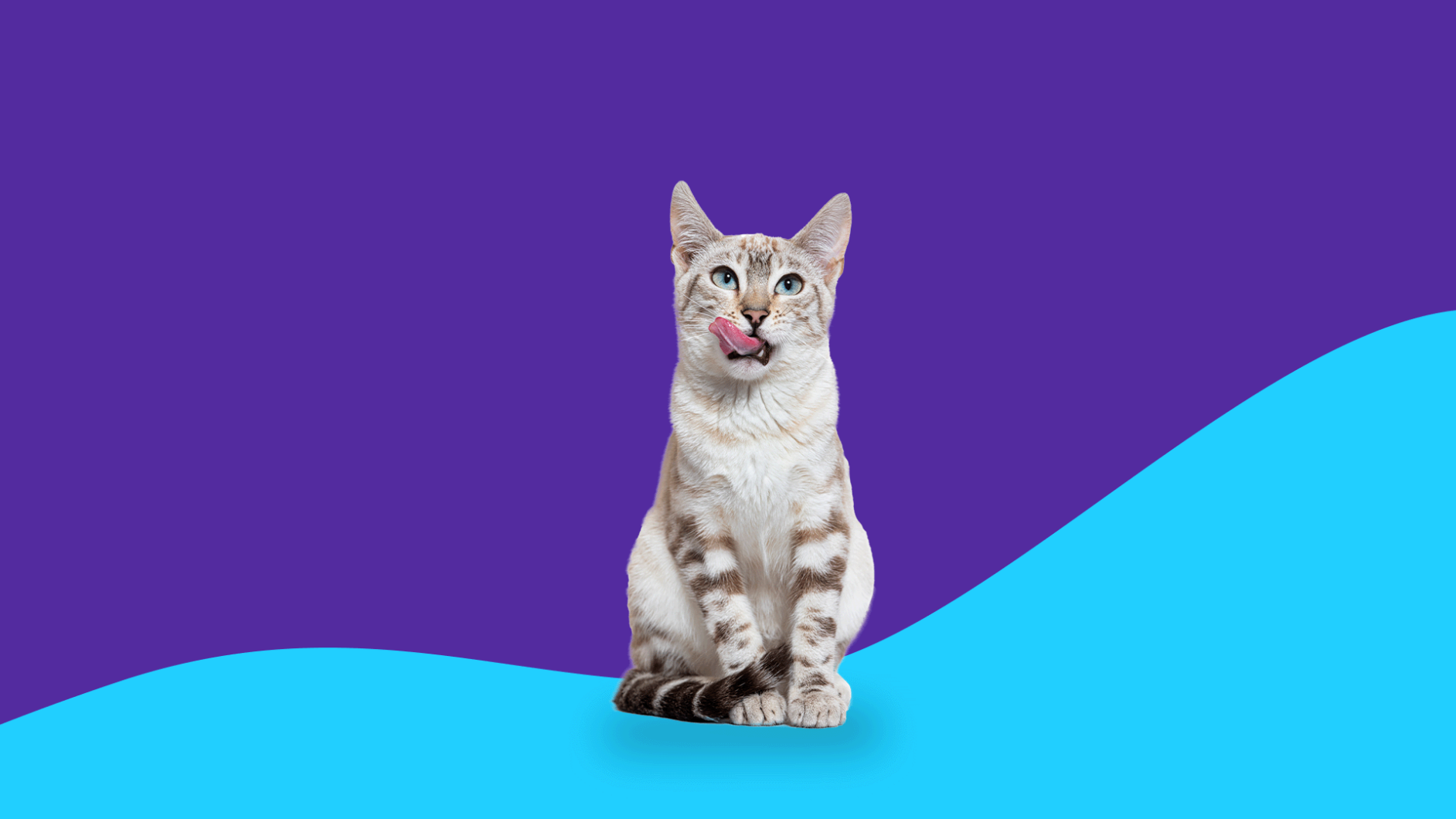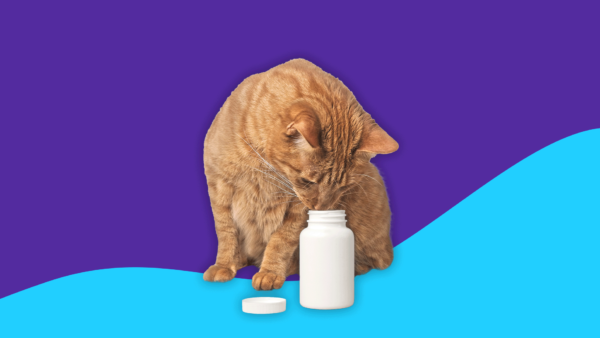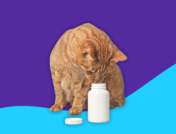Key takeaways
Amitriptyline is used to treat anxiety, behavior disorders, bladder inflammation, and chronic pain or itching in cats.
The standard amitriptyline dosage for cats is 0.5–2 milligrams (mg) per kilogram (kg) of body weight daily.
The most common side effects of amitriptyline in cats are drowsiness, constipation, and dry mouth.
Do not give amitriptyline to cats if they are allergic to amitriptyline.
Amitriptyline, known by the brand name Elavil, is an antidepressant commonly used in cats to treat behavior issues and prevent bladder inflammation symptoms. Cat behavior problems that respond well to amitriptyline therapy include anxiety, urinary marking, excessive grooming, biting, aggression, and other issues. Veterinarians may also use it as an add-on treatment to relieve chronic pain or itching. The U.S. Food and Drug Administration (FDA) has not approved the veterinary use of amitriptyline, so all these treatments are considered off-label uses.
RELATED: Save up to 80% on amitriptyline
What is amitriptyline used for in cats?
Although amitriptyline is not FDA-approved for use in cats, veterinarians commonly rely on it to treat anxiety, inappropriate urination, excessive grooming, and feline idiopathic cystitis (FIC). It’s a useful adjunct medication for chronic pain or excessive itching.
Anxiety
In cats, anxiety manifests itself in several ways. Anxiety in cats may present itself as peeing, hiding, running away, biting, trembling, panting, meowing, salivation, and so on. Anxieties in cats come in a variety of types, but the most common are separation anxiety (getting upset when people leave) and situational panic or stress. Amitriptyline relieves anxiety in several ways. First, it changes the chemistry of the brain by increasing the levels of serotonin at nerve junctions, which works as a long-term treatment for anxiety. It also acts like an antihistamine, sedating and calming the cat. It has anticholinergic effects that cause sedation but can also relieve physical symptoms like excessive salivation.
Urine marking
Urine marking and other difficult cat behaviors like biting, chewing, clawing, and aggressiveness are first treated with behavior modification and environmental changes. When that’s enough, drugs like amitriptyline and similar antidepressants and other antidepressants are tried. Veterinary professionals don’t know why amitriptyline works to calm undesired behaviors, but it may have something to do with its sedative effects.
Excessive grooming
Excessive grooming in a cat may be a worrisome and even self-mutilating behavior. It has several causes, including anxiety, behavior problems, and nerve problems. Amitriptyline addresses all three.
Urinary bladder inflammation
Amitriptyline is commonly used off-label in humans to treat bladder inflammation (interstitial cystitis). It’s widely used among veterinarians to treat the symptoms of feline lower urinary tract disease (FLUTD), also called feline idiopathic cystitis. The word “idiopathic” means that there is no identifiable cause. Veterinarians use a large variety of drugs and other treatments for this problem, so amitriptyline is usually added to these different treatments or used as a long-term preventive treatment, though its effectiveness is debated.
Chronic pain and itching
Amitriptyline quiets pain signals in the nervous system. Since itching uses the same nerves as pain, amitriptyline can help relieve chronic pain and itching if nerves cause the problem. For these conditions, veterinarians usually start with other nerve drugs like gabapentin as their first choice. Amitriptyline is used as an add-on treatment to provide further relief.
Is amitriptyline safe for cats?
Veterinarians consider amitriptyline safe to use in cats, but amitriptyline may cause side effects in cats that aren’t seen in dogs or people. For instance, some cats may stop grooming, and their coat will become messy.
Amitriptyline should never be given to a cat that is allergic to amitriptyline or similar drugs called tricyclic antidepressants.
It should also never be given to a cat taking monoamine oxidase inhibitors (MAOIs).
Because of the risk of dangerous side effects, veterinarians are cautious about using amitriptyline in cats with certain conditions, such as:
- Diabetes
- Problems with seizures
- Thyroid disorders
- Abnormal heart rhythms
- Liver problems
- Dry eye
- Glaucoma
- Pregnant cats
- Cats that are nursing their young
Before giving amitriptyline to a cat, tell the veterinarian about all the conditions the cat has to ensure it’s safe.
Side effects of amitriptyline in cats
In cats, the most common side effects of amitriptyline are:
- Sedation
- Dry mouth
- Constipation
Other less common adverse effects in cats include:
- Drooling
- Loss of appetite
- Vomiting
- Coordination and balance problems
- Disorientation
- Trouble peeing (urinary retention)
- Unkempt or messy coat due to lack of grooming
The most serious side effects are rare but could be hazardous. These include:
- Seizures
- Changes in the heart’s rhythm
- Abnormal bleeding
Take the cat to a veterinarian if you notice any more serious side effects. Common side effects should not be a worry unless they worsen or persist for a long time. In those cases, talk to a veterinarian.
Interactions of amitriptyline with other pet meds
Before giving your cat amitriptyline, tell the veterinarian about all the prescription drugs, over-the-counter medications, nutritional supplements, and herbal remedies you give the cat. Tell the vet how much and how often the cat gets these drugs or supplements. Additionally, certain conditions, such as liver or kidney diseases, may interact with amitriptyline.
Tell the veterinarian if the cat is wearing or has recently worn a flea collar. It may contain a drug that can cause serious side effects if the cat is given amitriptyline.
Veterinarians are most concerned about amitriptyline’s drug interactions with:
- Monoamine oxidase inhibitors (MAOIs): MAOIs are used for treating depression and other neurologic conditions, including the antibiotic linezolid, the senility drug selegiline, and the topical flea medication amitraz. These drugs must be stopped at least 14 days before the cat can safely take amitriptyline. Flea and tick collars sold on pet store shelves sometimes contain amitraz, so read the ingredients carefully if the cat is on amitriptyline.
- Central nervous system depressants: Drugs that make the cat sleepy, such as opioids, benzodiazepines, other antidepressants, and CBD, may worsen the sedative effects of amitriptyline.
- Selective serotonin reuptake inhibitors (SSRIs): These drugs, such as fluoxetine, are used to treat anxiety, aggression, and urine marking in cats.
- Sympathomimetics: These drugs, such as phenylpropanolamine, are used to treat urinary incontinence.
- Anticholinergic drugs or Antihistamines: Drugs such as clomipramine, chlorpheniramine, diphenhydramine, or clemastine are used to treat allergic skin disease and overgrooming in cats.
- Heartburn and ulcer medications: Drugs such as cimetidine that are used to treat gastroesophageal reflux disease (GERD)
- Heart rhythm drugs: These medications, such as quinidine, treat irregular or fast heart rhythms.
- Antifungal medications: Drugs such as terbinafine.
Amitriptyline dosage for cats
The standard amitriptyline dosage for cats is 0.5–2 mg/kg daily.
This can be given as one daily dose or divided into two daily doses.
While this is the standard dosage for anxiety or behavioral issues, veterinary professionals will dose the cat differently for other conditions:
- For behavior disorders: 0.5-1 mg/kg once daily OR 2.5mg-12.5mg once daily.
- For neuropathic pain: 2.5–12.5 mg given once per day
- For itchy skin (pruritus): 2.5-12.5 mg given once per day OR 2.5–7.5 mg twice per day
- For bladder inflammation (idiopathic feline lower urinary tract disease): 2.5 to 12.5 mg per day
There are no veterinary formulations of amitriptyline. Pet parents will either have to use prescription tablets made for humans or tablets or oral suspensions prepared by a compounding pharmacy.
Can cats overdose on amitriptyline?
In cats, an amitriptyline overdose can be dangerous, causing life-threatening heart rhythm problems or cardiovascular collapse. If you think a cat has been given too much amitriptyline, contact a veterinarian, veterinary hospital, or animal poison control center. Signs of an amitriptyline overdose in cats may include vocalization (meowing and other noises), poor balance or coordination, agitation, lethargy, dilated pupils, disorientation, and fast heartbeats. If these signs are noticed, take the cat to a veterinarian or veterinary hospital.
There is no maximum amitriptyline dosage specified for cats. The highest published recommended dose is 2 mg/kg every once daily. Do not exceed the prescribed dosage.
Can I give my cat amitriptyline every day?
Amitriptyline is usually used as a long-term treatment. It may take several weeks of daily dosing before the cat’s behaviors or symptoms improve. Once symptoms have resolved, the veterinarian may stop the treatment. However, the cat will be given a gradually decreasing dose to prevent withdrawal symptoms such as vomiting, shaking, or agitation.
How to give your cat amitriptyline
Most vets will ask cat owners to dose the cat once daily, but twice per day is also possible. For amitriptyline to work, it’s very important not to miss doses. It will take several weeks of faithful dosing before you notice improvements in the cat’s behaviors or symptoms.
- Follow all the veterinarian’s instructions.
- Do not change the dose or dosing schedule.
- Amitriptyline can be given with or without food. If the cat vomits or gets sick after a dose, try giving the dose with food.
- If you don’t know how to give tablets to a cat, ask a veterinary technician or other veterinary professional to demonstrate the proper technique. You can also get a pill plunger, but have a veterinary professional show you the correct method.
- Alternatively, the veterinarian could supply you with an amitriptyline oral suspension prepared by a compounding pharmacy. Make sure you shake the bottle before measuring each dose. Use a calibrated oral syringe to measure doses.
- If a dose of amitriptyline is missed, you have two options. You can give the dose when remembered, but give the next dose 12 hours later (or whatever duration the veterinarian specifies). You can skip the missed dose and give the next dose as scheduled. Do not give a double dose to make up for a missed dose.
- Do not stop dosing the cat unless the veterinarian tells you to. Doses may need to decrease to prevent withdrawal symptoms gradually.
- Store amitriptyline tablets at room temperature.
- Follow the storage and disposal instructions given by the pharmacist or veterinarian for any oral suspension of amitriptyline.
Amitriptyline alternatives for cats
For anxiety or behavior problems, veterinarians are more likely to start with reinforcement-based behavior training and changes to the environment. If drugs are necessary, selective serotonin reuptake inhibitors (SSRIs) like fluoxetine are often a first choice. Other alternatives include clomipramine, other tricyclic antidepressants, and buspirone. If anxiety is situational, like thunderstorms, benzodiazepines can be used as needed to calm the cat.
Natural products like cheek gland pheromones can also calm a cat or improve behaviors.
Amitriptyline is used to relieve symptoms of feline idiopathic bladder inflammation. The treatment is complex and could involve any number of medications, including antibiotics, fluid therapy, pain relievers, sedatives, and other drugs. Amitriptyline is also a long-term preventive treatment for feline idiopathic cystitis, along with dietary and environmental changes. It’s usually combined with other medications, such as glycosaminoglycans, glucosamine-chondroitin supplements, and pheromones.
Summary
Veterinarians commonly use amitriptyline to treat anxiety, behavior problems, bladder inflammation, chronic nerve pain, and chronic itchy skin in cats. It’s not always a first choice, but it is safe and effective if given under the direction of a veterinarian.
Sources
- Amitriptyline, Plumb’s Veterinary Medication Guides
- Amitriptyline, VCA Animal Hospitals
- Amitriptyline chloride prescribing information, DailyMed (NIH National Library of Medicine)
- Behavior problems of cats, Merck Veterinary Manual
- Drug dosages for behavioral therapy in dogs and cats, Merck Veterinary Manual
- Idiopathic feline lower urinary tract diseases: Therapeutic rights and wrongs, World Small Animal Veterinary Medicine
- Management of refractory inflammatory feline lower urinary tract disease, DVM 360
- Plumb’s Veterinary Drug Handbook, 7th ed
- Veterinary behavior medications: Which medication, which patient?, Today’s Veterinary Practice











